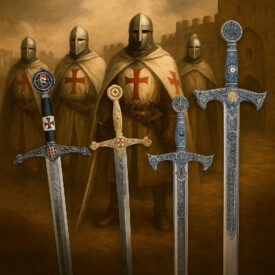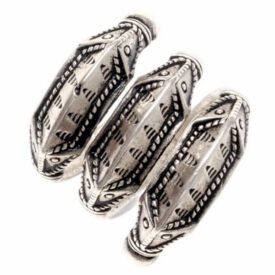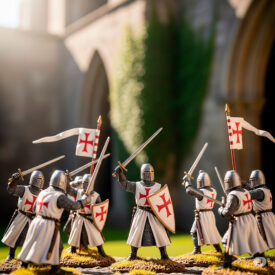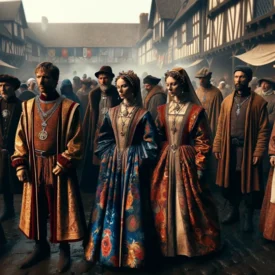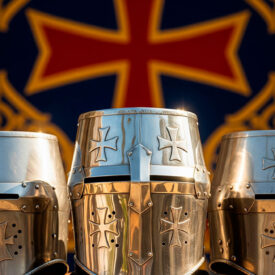Legend has it that, upon crossing the threshold of a Templar chapel for the first time, one felt the world shrink to the white of the habit, the red of the cross, and the silence of the vows. This powerful yet simple image encapsulates why Templar crosses continue to fascinate: they are not mere adornments, but emblems that condense faith, war, ritual, and symbolic power.
The Origins and Symbolism of the Templar Cross
The Order of the Temple was founded in Jerusalem at the beginning of the 12th century with the intention of protecting pilgrims traveling to the Holy Land. Among their attire and marks of identity, the cross held a central place. In 1147, Pope Eugene III formally consecrated the use of a red cross that the knights would wear on their white mantle, transforming a sign of belonging into a public symbol of martyrdom, sacrifice, and commitment.
The Templar cross was not unique in design. Throughout time and space, the brothers of the Temple, their sergeants, and their encomiendas (commanderies) used variants that responded to hierarchies, regions, or specific meanings. This mosaic of forms allows us today to trace religious, military, and even cryptographic uses within the Order.
Essential Chronology
To understand the evolution of Templar crosses, it is helpful to review a condensed chronology that puts dates, decisions, and milestones in order.
| Year | Relevant Event |
|---|---|
| 1118-1119 | Founding of the Order of the Temple in Jerusalem by Hugues de Payens and other knights. |
| 1147 | Pope Eugene III officially authorizes the Order’s use of the red cross, consolidating its emblem. |
| 12th-13th Centuries | Diversification of crosses (patée, tau, Greek, Jerusalem) according to regions and functions. |
| Late 13th Century | Templar encomiendas and seals show iconographic variety; crosses appear on tombstones and architecture. |
| 1307 | Mass arrests of Templars begin in France; symbols of the Order take on varied interpretations. |
| 1312 | Official dissolution of the Order by papal bull Vox in excelso; Templar iconography disperses. |
| Modern and Contemporary Ages | The Templar cross reappears in municipal heraldry, associations, and popular culture with new interpretations. |
Types of Crosses: Forms, Meanings, and Historical Examples
There is no definitive catalog of all the crosses used by the Templars, but we can identify several that were especially relevant in documentation, architecture, and ritual objects. Below is a tour of the most representative variants.
Latin Cross
Description: The cross with the longer lower arm; the classic religious image in Western Christianity. Templar Use: Very present in Benedictine monastic churches and in Romanesque and Gothic pilgrimage churches, especially along the Camino de Santiago; in Spain, the Latin cross was associated early on with the Templar presence.
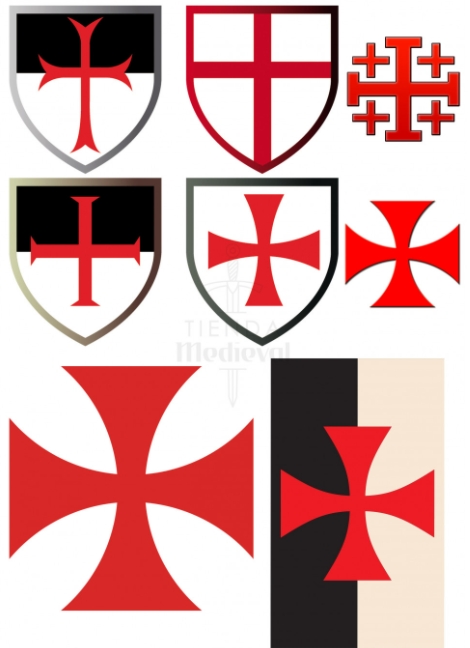
Patée Cross (Croix Pattée)
Description: Arms that narrow towards the center and widen at the ends; the shape evokes a paw or fins. Meaning: Symbolizes openness to the four cardinal points, the evangelists, and the elements.
Historical Context: This cross is one of the most recognized as a “Templar emblem.” It frequently appears on seals, buildings, and documents linked to the Order. Color was also a marker: the red patée cross is associated with the Templars, the white with the Hospitallers, and the black with the Teutonic Knights.
Tau Cross
Description: In the shape of the letter T (tau); simple but full of meaning. Symbolic Meaning: Associated with the sacred and in some contexts with internal hierarchy within the Order. The Tau is a letter with Hebrew and Greek roots and connections with ancient Christian practices, such as the cult of Saint Anthony. For the Templars, it could function as a symbol of divine election (electus Dei) and as a sign of ritualistic reservation.
Patriarchal Cross
Description: Cross with an additional upper crossbar; triple-bar appearance. Use: Associated with hierarchies and reliquaries within the Order. Some testimonies indicate that it was one of the first crosses carried by the Templars around the year 1118, worn on the left arm of their white mantle and sometimes painted vermilion.
Celtic Cross / Maltese Cross
Description: Crosses with decorative ends that can terminate in points or semicircles; the variants of the Hospitallers and the Templars show differences in their finishes. Meaning: It is linked to octagonal motifs and a broader symbolism that connects with the so-called eight beatitudes, sometimes represented in eight-pointed crosses.
Jerusalem Cross
Description: A central cross with four smaller crosses in the quadrants. Interpretation: The four straight ends have been read as the four corners of the world, the four evangelists, or the four elements. It was an emblem of presence in campaign and of connection with the holy city of Jerusalem.
Byzantine / Greek Cross
Description: Equal arms that cross in the center, sometimes with pointed ends; a common form in the Orthodox tradition. Use: Found in encomiendas (commanderies) and in iconography that connects Eastern influence in medieval Christianity.
How to Identify a Templar Cross in Stone, Seal, or Fabric
Reading a cross on a historical support requires attention to context. Not every red or patée cross is automatically Templar; there are indicators that help us establish a plausible relationship:
- Location: Churches linked to Templar encomiendas, pilgrimage routes, and locations of ancient possessions are a first clue.
- Material and Technique: Seals and tombstones with relief crosses often date from the High Middle Ages; the carving or sealing technique can help date the object.
- Complementary Iconography: Figures of knights, unique horse motifs, Christian inscriptions, or pilgrimage motifs increase the likelihood of a connection with the Temple.
- Color and Arrangement: In textiles, the presence of a red cross on white on the left arm or on the mantle is a strong indicator, although not exclusive.
Comparative Table: Types of Cross, Features, and Context
| Type | Features | Context / Use |
|---|---|---|
| Patée Cross | Arms widening at ends, symmetrical shape | Seals, buildings, military order badge |
| Tau Cross | T-shape, simple | Internal hierarchies, ritual symbolism |
| Patriarchal Cross | Additional upper crossbar | Reliquaries, rank insignia |
| Jerusalem Cross | Central cross with four small ones | Symbol of campaigns and connection to the Holy Land |
| Greek / Byzantine Cross | Equal arms, Eastern aesthetic | Encomiendas and art with Eastern influence |
The Templar Cross in Material Life: Seals, Standards, and Reproductions
The Templars not only wore crosses on their clothes: they depicted them on seals that certified acts, on tombstones that marked graves, on standards that waved in campaign, and on relics they treasured. This material presence explains why today Templar replicas and motifs appear so frequently in historical reproductions and popular iconography.
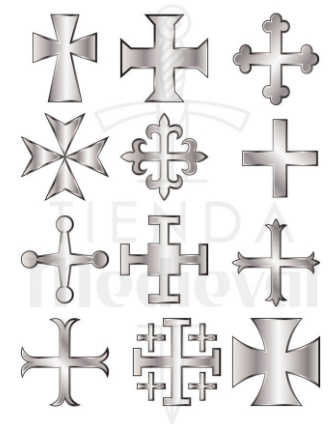
When observing a replica, pay attention to the fidelity of the finishes, the type of enamel, and the fastening method: pieces that respect historical proportions and techniques better convey a sense of authenticity. At the same time, many regional and temporal variations allow artistic liberties without breaking historical coherence.
Replicas, Standards, and Swords: The Sign that Accompanies the Object
Commercial reproductions are a bridge between the present and the past. By wearing a Templar cross on a standard or engraved on a sword, the aim is a symbolic connection with the narrative of the Temple: sacrifice, protection of the pilgrim, and warrior order.
Regionalisms and Variations: How Territory Shaped the Cross
The shape of the cross often responds to symbolic geography: in Portugal and Western-influenced regions, the patée cross had a greater presence; in Galicia and León, the Tau appears in monastic contexts; in Castile and areas with strong ties to the Holy Land, Greek or Latin type crosses are documented. This symbolic biodiversity not only reveals aesthetic tastes but also networks of contact, liturgical influences, and power disputes among orders.
The Esoteric and Cryptographic Dimension
Some sources indicate that certain cross designs served as the basis for secret alphabets and internal codes. The eight-pointed cross and other octagonal variations have been interpreted as keys for coding systems in commercial documents or confidential messages. Although direct evidence is limited, the use of shared symbols and particular signs in correspondence and seals makes the existence of recognizable symbolic conventions for members of the Order plausible.
Legacy, Heraldry, and Modern Reinterpretations
After the dissolution of the Order, its symbols did not disappear: they reappeared in local heraldry, in reinterpreted medieval tombstones, and, centuries later, in popular culture. The Templar cross was adopted by many different organizations, sometimes for purposes of prestige or mysticism. In some contemporary municipal coats of arms, such as the mentioned case of Villamediana de Iregua, the cross acts as a bridge between a legendary memory and a modern local identity.
How to Read the Cross Today: Keys for the Enthusiast and Researcher
- Ask about the context: Where was the cross found? On what support? Archaeological data remains the key piece.
- Interrogate the technique: The way a cross is carved, painted, or printed helps to date it and place it within a specific artistic tradition.
- Look for correspondents: Seals, inscriptions, or nearby motifs (animals, human figures, religious scenes) point to connections with orders or families.
- Do not presuppose exclusivity: Many crosses were used by different orders and communities; identification requires cumulative evidence.
Stories in Stone: Real Examples of Templar Crosses
Preserved tombstones and seals tell stories of men and places. In the Iberian Peninsula, multiple parishes display patée crosses in keystones and corbels; in France, the Vexin records a notable density of patée crosses that was reinterpreted by later societies as a symbol of antiquity or mystery.
These tangible traces allow us to connect the aesthetics of the cross with specific community uses: commemorating those fallen in battle, marking land donations, or signaling Templar guardianship over a hospital or pilgrim hostel.
From History to Object: Temporary Tattoos and Symbolic Reproduction
The permanence of the Templar cross in the collective imagination is also manifested in contemporary objects that reproduce its forms. A modern example is temporary tattoo sheets with medieval cross designs, which allow enthusiasts and re-enactors to wear the symbolic mark for a time without permanently altering the skin.
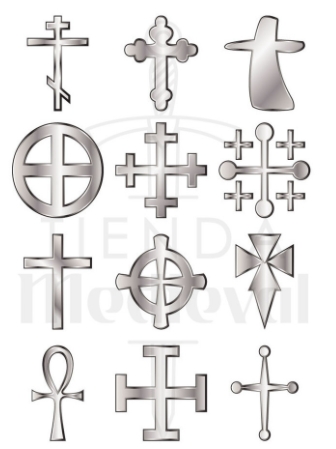
Final Reflection for the Enthusiast
Templar crosses teach us that a symbol is not static: it changes over time, is reinterpreted, and reappears in new contexts. When looking at a patée cross carved in stone or a tau painted in a manuscript, you are tracing a line with men who lived the tension between monastic vows and war, between devotion and the pragmatism of power.
If medieval iconography fascinates you, look for the material trace: preserved seals, tombstones, and fabrics. There you will find a complex history, full of nuances, that goes far beyond the romantic myth and yet retains that epic glow that continues to fuel the imagination.








